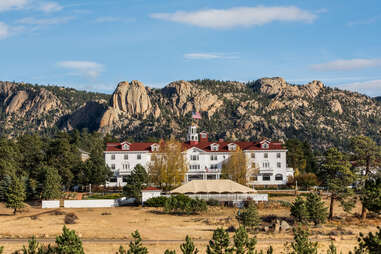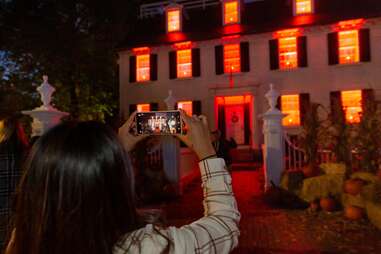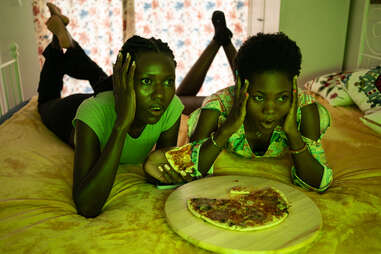The Growing Trend of Horror Movie-Inspired Vacations
Some people simply watch scary movies. Others take the show on the road.
Growing up in a rural area outside of Dayton, Ohio, Conner Gossel says there wasn’t much to do except create his own fun. His dad was a cinephile with a large film library that was noticeably lacking in horror films. “So, naturally, those were the ones I wanted to watch more than anything,” he laughs.
Waiting until his parents fell asleep, Gossel would sneak down to the basement to watch the few scary movies they did have, like Signs, The Village, and The Sixth Sense. It took Gossel years to finish the films. “One of my parents would wake to the sounds every time, come downstairs, scold me, send me back to bed, and leave me on a perpetual cliffhanger” he recalls. Surrounded by cornfields and gifted with an active imagination, Gossel wasn’t deterred. His love of fictional horror, as well as real-life ghost stories from shows like Ghost Hunters, led him to pursue the supernatural with gusto.
Eventually, Gossel realized he could bring these on-screen experiences into his off-screen life, renting out the historically haunted Hill View Manor in New Castle, Pa for an overnight experience with like-minded friends. That night birthed Gossel’s career as the Haunted Historian. Through his Instagram platform, television appearances, and podcast, he’s been exploring some of the scariest places on earth—and helping the rest of us understand why we find horror and hauntings so fascinating.

Gossel has tapped into a popular niche; Americans love a good scare. According to a 2021 TripAdvisor report, October 31 is the most popular day of the year to check into a hotel in the United States. Halloween in general is popular, so it's no surprise that many Americans tie their travel plans to their love of the weird and creepy. Gossel cites recent surveys by Barna and OnePoll that show an increasing openness to spiritual and supernatural experiences as driving the haunted travel industry as a whole, and says the number of haunted sites available to tourists has increased in recent years. Some tourists choose to visit actual haunted places, like Hill View Manor, while others focus on the sites where popular horror movies were filmed, like Buffalo Bill’s lair from Silence of the Lambs.
Horror movies in particular seem to go hand in hand with travel—after all, taking a trip usually involves some amount of venturing into the unknown and unfamiliar. There’s an entire genre of horror movies that use the trope of travel gone wrong, says German filmmaker Uwe Boll. He’s even managed to work those plot lines into some of his movies. For example, he explains, “In Blackwoods, Patrick Muldoon encounters the rustic charm of his girlfriend's parents in a quaint forest dwelling, setting the stage for a gripping struggle for survival.”

Rural country settings are often an ideal backdrop for cinematographic horror. These quiet, desolate spots are perfect for a jump scare (or maybe just the anticipation of one). In another film Boll worked on, House of the Dead, a gaggle of teens find a zombie-infested house while exploring a dark forest. “It resonates with everyone who has ever embarked on a camping adventure,” Boll says. He explains that movies like Sleepaway Camp and Friday the 13th strike a nerve with travel buffs because so many common outdoor experiences often go awry. “It creates a sense of connection that adds an extra layer of enjoyment to the films.” Case in point: The lake where Friday the 13th was filmed is a popular camping spot for that exact reason. While guests know that the movie is fiction, just being in that setting provides the adrenaline rush so many horror travel enthusiasts crave.
Hotels are also popular spots to tap into the horror genre, perhaps because they are the sites of particularly vulnerable activities (sleep, primarily) and have housed so many other guests. Jennifer Billock, a journalist and fortune teller, often bases her travels around movies that freak her out. One top spot on her list was The Stanley Hotel, where The Shining was filmed. “I had this little dream that I’d catch Stephen King’s inspiration bug and suddenly churn out an amazing horror novel myself,” she says. In addition to being a filming location, the hotel is purported to be truly haunted. When Billock and her friend stayed, they chose one of those haunted rooms (of course). While inspiration didn’t strike, adrenaline did. “I had terrible nightmares,” Billock says.

Beyond individual experiences, sites like these can also bring horror movie buffs together. One of Boll’s favorite movies is Dawn of the Dead, a zombie apocalypse adventure filmed in a Pittsburgh mall. That mall has now become a travel destination in its own right, hosting a festival each year that draws horror movie buffs from across the world. The festival is so popular that event planners have to reserve a block of rooms at a nearby Hilton.
And then, of course, there’s Salem, Massachusetts, the site of both real-life Witch Trials and scads of movies such as Hocus Pocus, a family-friendly Halloween film with a cult following that draws serious crowds. The frenzy around Salem has grown each October to a fever pitch, but that doesn’t keep witchy tourists away. The city of Salem earns 30% of its yearly tourism profit in October alone.
Travel writer Yashy Selvadurai Murphy decided to take her 11-year-old daughter to Salem on Friday the 13th, despite knowing it would be one of the busiest weekends of the year. Murphy says the goal was to both educate about the Witch Trials and have some fun with a beloved film, too. “I’ve always loved Halloween, and now I have a little mini me,” she says. They were able to book experiences ahead of time and snap photos at popular Hocus Pocus filming locations and historical spots before returning to their hotel room to watch the film once again. Murphy says it’s possible to experience the fun amidst the chaos. “But the chaos is also fun,” she adds.

When vacations are often touted as relaxing breaks from reality, why do so many tourists seek creepy, scary, and horror movie-inspired trips instead? To put it plainly: It’s a rush.
“I’ve always loved horror movies and anything ghostly and ghastly,” says Billock. “For me it's the thrill of both getting to experience someone else’s inspiration to create something sinister, and to possibly experience something myself.”
According to Gossel, whether tourists seek real experiences or more manufactured ones like joining the fray in Salem, the drive is usually adrenaline and curiosity. Tourists, he says, want a unique experience that a laid-back vacation just doesn’t provide. They prefer something that makes their skin crawl, that provides a story they will tell for years. Even on excursions where nothing paranormal has happened, Gossel, like most horror fans, finds excitement in the mere possibility that it might.
“People love scary stories just as much as they love scary podcasts, just as much as they like watching a horror movie, just as much as they love haunted houses and paying top dollar to let professionals freak them out,” Gossel says. He believes a single motivation drives their interest: "How can we push the envelope? How can we create an experience so visceral we forget it's fake? How can we immerse ourselves in an alternate reality that answers the age-old curiosities humans have held for the afterlife, while ensuring every fiber of our being is teetering on the edge?"
Watching a scary movie is a good start. But to make it feel real, you might want to take a trip.

